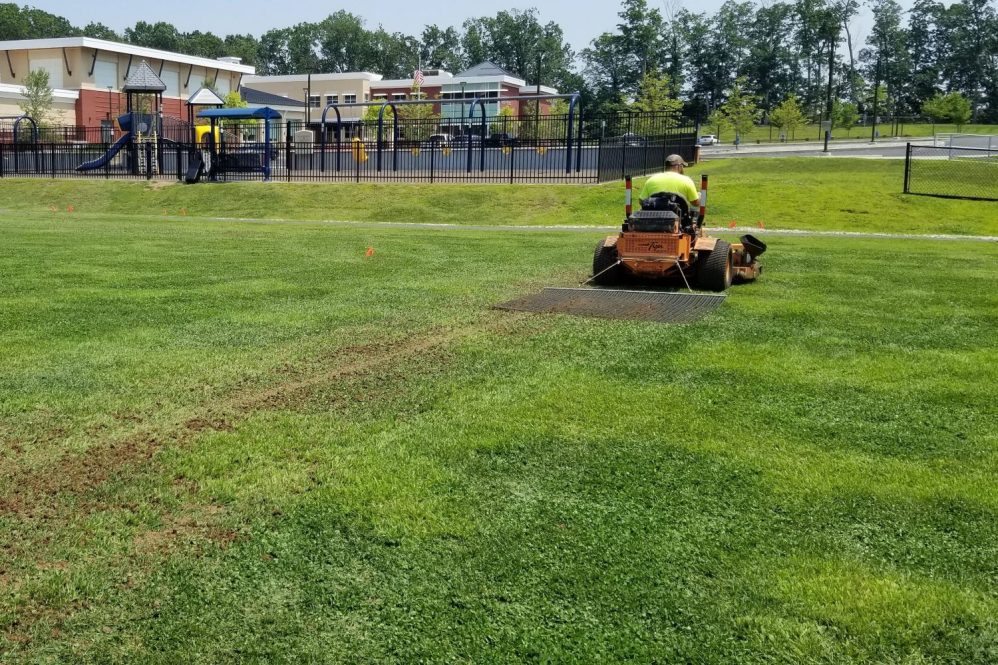A new online version of the UConn Extension’s existing Athletic Field Assessment Form provides school grounds managers and turf professionals with an easier way to document, monitor, and maintain safe athletic fields. Developed by a team from the Sustainable Landscape Program, the new tool was built on a 14-year legacy of the paper assessment form to create a mobile-friendly format, making it easier to assess turf health, track maintenance activities, and advocate for resources.
The idea for digitizing the original paper scorecard was sparked when Vickie Wallace, senior extension educator, gave a presentation at a National Sports Field Managers Association (SFMA) conference several years ago. She shared data collected from an Integrated Pest Management (IPM) project focused on the assessments of Connecticut school athletic fields and surrounding landscapes. She was aided in the three-year data collection effort by the late emeritus professor, Bill Dest, students, and project staff member Alyssa Siegel-Miles.
“At the end of my presentation, a colleague from the turfgrass seed industry approached me and said, ‘your assessment form could be a really cool app,” Wallace says. That conversation changed the direction of a portion of UConn’s next IPM grant proposal, which ultimately included development of the new online assessment tool.
Building on a Proven Framework
Wallace, Dest, and UConn professor Jason Henderson from the Department of Plant Science and Landscape Architecture were the primary authors of the original assessment form. The form has been in use for well over a decade and remains available on the UConn School IPM website. Designed to support school grounds managers and assess the safety and quality of athletic fields, both the paper assessment form and the new assessment tool assigns numerical ratings to a variety of factors that can influence the playing surface quality of the athletic field, including turfgrass density, surface uniformity, and wear damage, weed and pest presence, along with the ability to record necessary cultural maintenance such as mowing, irrigation, nutrient applications, cultivation and overseeding, and turfgrass health.
“We worked hard to build a comprehensive tool that municipal and school grounds managers could use to inform and communicate with administrators about management practices related to field care,” Wallace says.
For many school grounds managers, especially those in K-8 settings, this tool becomes a powerful way to justify funding for overseeding, irrigation improvements, and other maintenance activities.
“I had a couple of school grounds managers tell me after one of our school grounds workshops that they hesitated to use the original assessment because when combining the category scores together, the final quantified number clearly highlighted the quality of the athletic field surface. The managers interpreted a low score to incorrectly mean they were doing something wrong, rather than recognize the score provided evidence that their overused fields required additional staff, supplies, and equipment to ensure quality playing surfaces,” says Wallace. “The tool was created to help them advocate for more resources and improve safety.”
By adding the opportunity to enter data from the field, store data related to maintenance inputs in situ, the tool allows the input of data to be easy and quick. There is no longer the need to make notes in the field and transfer the data to a paper or computer log later in the day.
Features and Flexibility
Now available as a web-based tool that can be accessed from both desktop and mobile devices, the Athletic Field Assessment Tool includes expanded functionality without a cost to input data. Managers can create an account and enter static field data like identified turfgrass species, renovation history, or soil type, along with dynamic reports on mowing, overseeding, cultivation, and turf quality ratings. The UConn Digital Experience Group worked with Wallace and Siegel-Miles to build the online tool.
Key features include:
- Turf Quality Rating on a 1–15 scale, with 15 being excellent
- Report types including weed or other pest presence and maintenance events
- Photo uploads for visual documentation
- Data filtering and report printing
- Unlimited field entries and ample data storage
“You can enter data for as many fields as you want, and tailor how often you assess them based on field use,” Wallace says.
Some managers conduct a varying range of assessments to monitor turf health and recovery from wear because they have both high school and elementary fields with different use levels. Data can be stored on the phone or ultimately transferred to a computer at the end of the season.
Feedback from school grounds managers played an important role in shaping the final product. The team tested beta versions and provided input to improve usability and relevance for turfgrass professionals.
A Tool for Communication and Collaboration
Because school grounds managers often communicate with school administrators or athletic directors, the tool helps them present data related to present day/current field conditions to support real time decisions related to field playability or event scheduling. The tool can also document, in an easily understood format, how routine management practices impact turfgrass health.
“Documenting the level of activity on a field helps justify why a field needs to recover or rest, or documenting wear damage on a field helps argue the need to rotate practices to another section of the field,” Wallace says. “It supports conversations with administrators and coaches, so they understand the importance of turf care.”
That value isn’t going unnoticed.
” I believe [the tool] can help professionals in our sports turf industry very much. It is also very user-friendly,” says Richard Calarco, CSFM, AOLCP, L&C Park Consultants, LLC; retired director of Parks and Recreation from the Town of Hebron.
This work relates to CAHNR’s Strategic Vision area focused on Fostering Sustainable Landscapes at the Urban-Rural Interface.
Follow UConn CAHNR on social media



